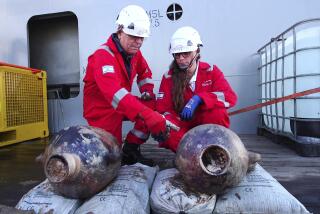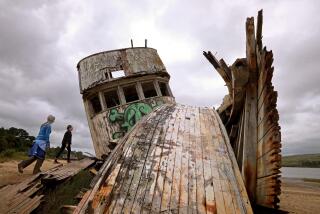Bronze Age Beauties
- Share via
After a decade of research and 22,413 individual dives by archeologists, the world’s oldest shipwreck, located 150 feet below the water’s surface off the southern coast of Turkey, has revealed all its treasures.
It may be 10 to 20 more years, however, before it has revealed all of its secrets. Nevertheless, the ship is already providing unprecedented insights into life around the Mediterranean in the 14th century BC.
The ship sank in 1316 BC just south of a rocky finger of land known as Uluburun. Protected from looters by its hidden location, the ship has proved a veritable time capsule--a conglomeration of the best merchandise from as many as 10 different Bronze Age cultures scattered around the Mediterranean.
Analysis of the materials is expected to provide a remarkably detailed picture of early trading routes and methods in the region. Archeologists are particularly interested in their findings because this is the period when the Greeks were constructing their great palace at Mycenae and colonizing the islands and shores of the Aegean and Ionian seas, George F. Bass of Texas A&M; University’s Institute of Naval Archeology said Wednesday in a lecture sponsored by the California Museum of Ancient Art. Bass headed the expeditions to the ship.
The sailors were the mercantile forebears of the Homeric heroes--Agamemnon, Achilles and Odysseus--who sailed to Troy a century later. The Uluburun shipwreck indicates that they were traveling farther and carrying more types of merchandise than anyone had ever suspected.
Among its cargo items were copper and tin from the land of the Hittites, raw glass from Canaan, terebinthine resin from Palestine, pottery from Mycenae and Cyprus, a gold scarab of Nefertiti from Egypt and the world’s oldest books. These materials are almost never found in land excavations.
“It’s an incredibly rich [time capsule], in addition to being an incredibly early one,” said archeologist Jeremy Rutter of Dartmouth College. “It’s singularly valuable--the kind of thing archeologists dream about.”
The shipwreck was discovered in 1982 by a Turkish sponge diver named Mehmet Cakir. Bass and his colleagues undertook the monumental task not only of recovering its cargo, but also of documenting each item’s archeological context in the same way they would have if it were a site on land. This had never before been done for a shipwreck, Bass said. They accomplished this, even though each diver could make no more than two 20-minute dives per day.
The main cargo of the ship, whose name has not been determined, was the raw material from which bronze is made--10 tons of copper and one ton of tin, enough to equip a small army. These metal ingots are the earliest ingots that have been definitively dated.
The team also found 149 Canaanite amphorae ranging in capacity from about seven quarts to about 28 quarts. One was filled with glass beads and several contained olives, but most held terebinthine resin from the Pistacia atlantica tree, which was widely used in incense and as a preservative in wine. The estimated one ton of the resin is the largest ancient deposit of the material ever found.
Other raw materials on the ship included logs of Lebanese cedar and African black wood, a whole elephant tusk and part of another, more than a dozen hippopotamus teeth, tortoise shells that were probably destined to become the sound boxes of musical instruments and ostrich eggshells that could be converted into ornate containers.
The ship also contained what Bass called “an astonishingly rich collection” of gold and silver jewelry, much of it apparently scrap destined for reuse.
One of the finest pieces is a figure of a nude female holding a gazelle in each hand. The figure is almost certainly that of a fertility deity, Bass said, and probably represents one of the three great goddesses of the Canaanite pantheon: Ashera, Anat or Astarte. “It may be the ship’s protective deity,” he noted, “but such figures are often royal gifts as well.”
Another valuable item was a gold scarab inscribed with the name and picture of Nefertiti, wife of the Egyptian pharaoh Akhenaten. Early in their exploration of the shipwreck, the researchers were uncertain of the contemporaneous importance of the scarab because they were unsure of the date the merchant trader sank. The accurate dating however, indicates that the ship sank some time after Akhenaten’s rule and indicates that the scarab, like many other items on board, was simply junk jewelry destined for recycling.
The dating itself was made possible by the discovery of a piece of what was clearly firewood. By matching the ring pattern of the firewood to a tree-ring chronology recently constructed by archeologist Peter Kuniholm and his colleagues at Cornell University, Bass’ group was able to determine that the ship sank in 1316 BC, plus or minus two years.
Because the ship contained large amounts of pottery, both to carry cargo and for the crew’s use, Bass said, dating the shipwreck will also provide firm dates for similar pottery found in land excavations, allowing researchers to better tie down timelines in the region.
The team is not certain who the sailors were, but is leaning to the possibility that their home was the ancient seaport of Ugarit at what is now Ras Shamra in northern Syria. Land excavations there have yielded storerooms with “large jars like ours with pottery inside” and other storerooms with amphorae waiting to be shipped out.
“No other place has yielded such precise parallels,” he said.
It will be some time before all the questions about the ship are answered, Bass concluded. “We have half a dozen full-time conservators working on the 20 tons of artifacts, and it will take them more than a decade to complete the job,” he said.
The museum will sponsor two other lectures in the series on new archeological discoveries from the Levant at the Gallery Theater in Hollywood on Nov. 7 and Nov. 20. For more information, call (818) 762-5500.
More to Read
Sign up for Essential California
The most important California stories and recommendations in your inbox every morning.
You may occasionally receive promotional content from the Los Angeles Times.










